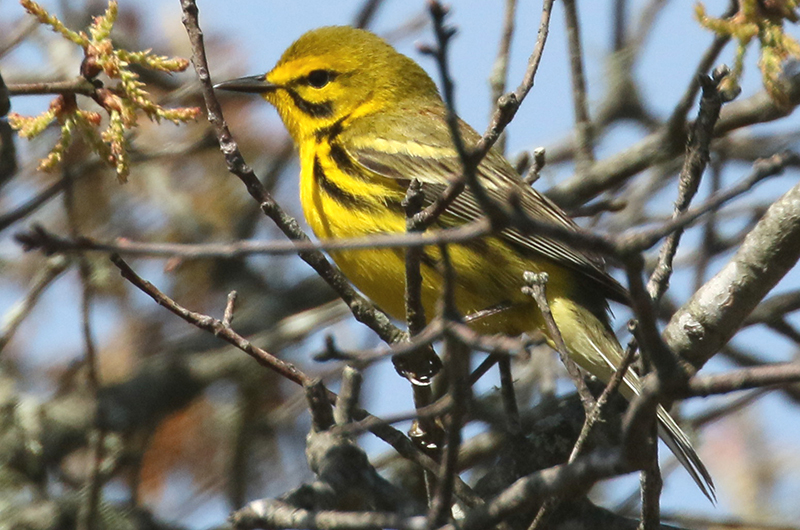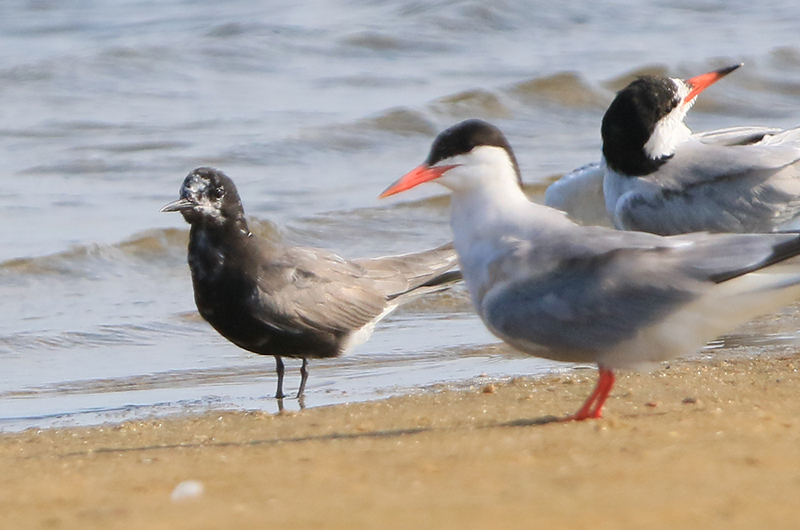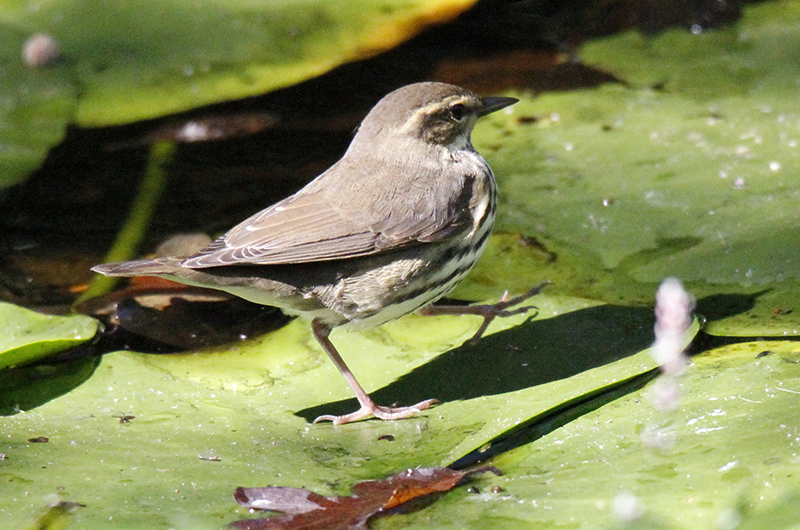The peak of migration is past, but that does not mean it is over. Four species were seen for the first time this year. Some others, which nest here while others will depart for more northern climes, are more abundant this week than they were last week.
May 22 was a busy day on our beaches. A first for the year was the sighting of a black tern found on Norton Point on May 22, a solitary individual within a flock of the much larger and lighter common and roseate terns. It was spotted by multiple observers including Amber Litterer, Susan Whiting, Allan Keith, Bob Shriber and Lanny McDowell. And Matt Pelikan found a dead northern fulmar on Norton Point — a seabird rarely seen from the Vineyard but regularly seen in the ocean to the south and east. Further down the beach, at Wasque, Ron Domurat spotted a lingering long-tailed duck, while Hans Goeckel found two laughing gulls on Cape Pogue.
Shorebird news comes from a recently plowed farm field in Katama, where on May 24 both Susan Whiting and I spotted a large flock of black-bellied plovers foraging on the sparsely vegetated soil. I counted 210 of them, and more were flying in as I departed. This is a much larger flock than has been on Norton Point, where on May 22 Susan Whiting and Allan Keith report 22 black-bellieds in addition to 70 ruddy turnstones, 80 sanderling, 20 dunlin and one semipalmated sandpiper. Margaret Curtin, Nancy Weaver and Luanne Johnson added a least sandpiper along the shores of Lagoon Pond on May 24.
Songbird migration continues as well. Two new songbirds for the year are a northern waterthrush and a willow flycatcher. The former is a transient that does not nest here, while the latter breeds in small numbers. Both were spotted by Allan Keith at Squibnocket on May 16. Several songbirds are not new for the year but still of interest. On May 18, Bob Shriber spotted a blue-gray gnatcatcher in Aquinnah, while Susan Whiting had a white-crowned sparrow at Quenames on May 19, and Allan Keith spotted a prothonotary warbler at Squibnocket on May 14. Another summer tanager was spotted by Rich Colter on May 22 along Lighthouse Road in Aquinnah on May 22, while on May 21 Deb Mello Orazem spotted the more common scarlet tanager (the only one of these species that nests here) as it was perched on the hood of her car.
The arrival of breeding species continues. Although most of these species have already been seen this year, their breeding population is still building up. Luanne Johnson spotted six chimney swifts at the Oak Bluffs Pumping Station, while Bob Shriber added red-eyed vireo, wood thrush and northern parula at the same location. In the state forest, Phil Edmundson heard and saw an eastern wood-pewee , while Bridget Dunnigan and Sea Williams spotted both black and white and prairie warblers there. At Priester’s Pond and in Aquinnah, Bob Shriber added red-eyed vireo, eastern wood-pewee, and six warblers: ovenbird, blue-winged, black and white, redstart, northern parula, and yellow.
The final migrant songbird sighting was Mike Tinus’ report of a red-breasted nuthatch in his Oak Bluffs yard on May 23. A small number of this species may nest on the Island, so we are not certain whether this counts as a migrant or a resident species.
Bird Sightings So what do birders do when the buzz of migration starts to peter out? Well, by the time that happens, the nesting season is well underway and interest shifts to trying to find evidence of nesting birds. Finding a bird on its nest is not easy, so we generally rely on sightings of them carrying either vegetation to build their nests or carrying food back to their nests to feed their young ones. This is not as easy as it sounds.
This week, evidence confirming nesting has been observed for the following nine species. On May 22, Hans Goeckel spotted bank swallows visiting nesting cavities on Cape Pogue, while that same day Ben Hughes discovered a well camouflaged killdeer nest with two eggs (she will lay four) in a Katama driveway. Tom Hodgson found a whip-poor-will nest (speaking of well camouflaged) in the southwest corner of the state forest. David Stanwood reports that the osprey at the Oak Bluffs Pumping Station is now feeding recently hatched chicks, and Luanne Johnson observed a courtship display of northern harriers at Katama on May 24. And Bob Shriber and Susan Whiting observed a pair of orchard orioles getting along quite well along Lighthouse Road in Aquinnah on May 25.
Birds nesting in nest boxes are easier to monitor. Chickadees are nesting in boxes in the yards of Greg Pattison, Susan Shea and Cynnie Wayman. Great crested flycatchers are nesting in boxes provided by Kathy Landers and Stephanie Mashek, while both Candy Lincoln and Jerry Twomey have screech owls. The antics of these nesting birds will keep their hosts entertained.
Nest boxes are not always needed. Jo Maxwell has been watching mourning doves for a while now and has two almost full grown squabs staying in one of her flower pots.
Finally, for the past week I have been seeing fish crows hanging out in downtown Oak Bluffs from Ocean Park to the Camp Ground. We have expected to confirm this species as a breeding species, but so far all the leads over the years have not panned out. But they are here now, although they tend to become fairly quiet and secretive when they are nesting. Maybe your observations will be the first to finally confirm them as breeding on the island.
Robert Culbert is an ecological consultant with Nature Watch LLC living in Vineyard Haven.










Comments
Comment policy »